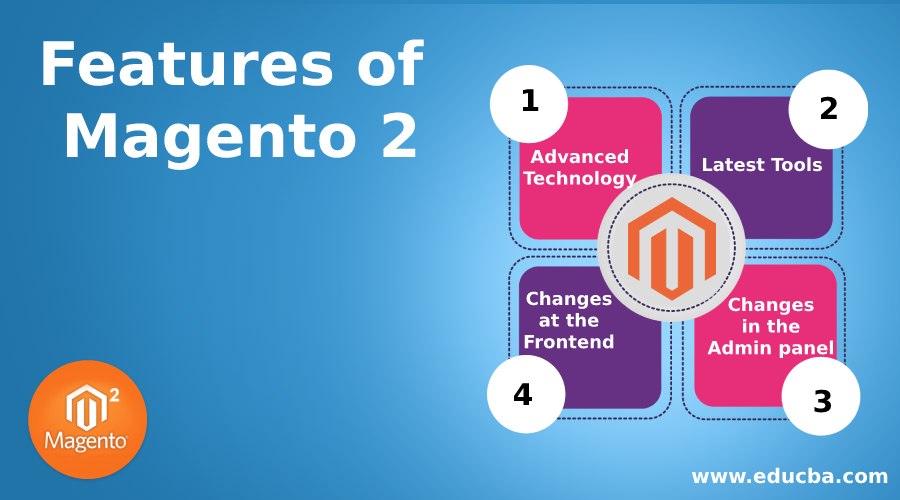Updated July 7, 2023
Introduction to Magento 2
Magento is a user-friendly customizable tool applicable for any e-commerce application, which is available as an open-source technology. The Magento tool is broadly known and chosen due to its significant features, namely the ability to facilitate any e-commerce-based applications, available as open-source free of cost, user-friendly appearance in the front-end interface, and flexible and expandable back-end database units.
Features of Magento 2
Below are the latest Features of Magento 2:
1. Advanced Technology
- Composer is a dependency manager working on PHP. We can declare dependencies, and the Composer will help us manage the dependencies, installing and updating them respectively. The composer simplifies the process of installing and updating the extensions and also updating Magento every time.
- Varnish 4 is an open-source HTTP accelerator that stores pages and other assets in memory to decrease the response time taken and the network bandwidth consumption.
- In Magento 1, Full Page Caching was only for the Magento Enterprise Edition whereas, in Magento 2, Full Page Caching is included in all editions, which allows the content to be cached from static pages, which eventually increases the performance and reduces the server load.
- RequireJS is a library that loads Javascript files on the fly and reduces the count of HTTP requests, enhancing the speed of the Magento Store.
- In Magento 1, the frontend was developed using Prototype as a language for Javascript, whereas, in Magento 2, the language used for javascript coding is jQuery.
- Knockout.js is an open-source Javascript library that helps implement the Model-View-ViewModel (MVVM) pattern and provides an easier way of developing frontend components.
- LESS is an open-source CSS preprocessor that supports the developer in writing different styles for a store. Maintenance and support for extensions are also very easy now.
- Magento UI Library is a modular front-end library with a group of mix-ins for general elements. Also, it helps enhance the developers’ efficiency when working on front-end tasks.
2. Latest Tools
- The merchants and developers can now test the Magento installation using the Magento performance Toolkit. This tool can also test the customizations done.
- Magento 2 Command Line Tool is a tool that runs a set of commands to clear the cache at the time of Magento installation; it also helps in re-indexing of the store, Backup creation, and activating the maintenance mode.
- Data Migration Tool helps the developers migrate the data from Magento 1.x to Magento 2. This tool includes verification, process tracking, function testing, and logging.
- Code Migration Toolkit helps the developers migrate the extensions and the customizations of Magento 1.x to Magento 2. Verifying and updating the extensions is required to make the Magento 1.x extensions compatible with Magento 2.
- There were many complaints that Magento 1 didn’t have enough documentation for the developers. In Magento 2, this problem has been solved, and an official Magento 2 Developer Documentation has been created. It contains the information for the developers, System Administrator and Quality Analysts.
3. Changes in the Admin panel
- The admin panel now allows inline editing as well. This helps in managing data more effectively.
- The product adds/edit page is essential in the admin panel. The experience of using this page has now been enhanced, and we can now manage the products in a step-by-step manner where the fields and import tools are separated into different sections.
4. Changes at the Frontend
- In the latest version, Magento also allows us to add videos to the product, enhancing how products are displayed.
- The checkout page has been simplified; users can now purchase a product in less time. It also increases the conversion rate of the store.
- Magento 2 allows the customer to register at the order success page, lessening the checkout process.
Features of Magento at a Glance
- Customer Segmentation and Personalization have made the shopping experience more interactive, enhancing conversion rates. Dynamic display of the products, Promotional offers for specific customers based on their features like gender, Age, Order History, etc., also boost the chances of a sale.
- Dynamic Rule-Based Product Relations assign rules to understand what products should be displayed for upselling and cross-sell for the different segments of Customers. Companies use condition-based tools to set the rules for targeting product suggestions.
- Elastic Search provides suggestions for spelling mistakes made by the customer and does synonym management to increase the relevancy of the search. It handles large Catalogues, which scales the search capacity.
- It boasts a powerful admin experience. An advanced and interactive User Interface makes the admin panel work easier. The dashboard helps monitor the business and analyze sales and other business-related data.
- The Magento Commerce Cloud has an AWS-based environment with high scalability and availability, High-Speed CDN, which provides a good user experience.
Conclusion
Based on the above features, we can say that Magento 2 is the best solution for an e-commerce business. Advanced technologies have made this platform more customer-centric, eventually increasing the store’s conversion rate. The upgradation from Magento 1 to Magento 2 has been very helpful for the developers, system admins, and Quality Analysts. Companies like Land-Rover, Timex, Timberland, etc., believe greatly in Magento 2.
Recommended Articles
We hope that this EDUCBA information on “Features of Magento 2” was beneficial to you. You can view EDUCBA’s recommended articles for more information.




